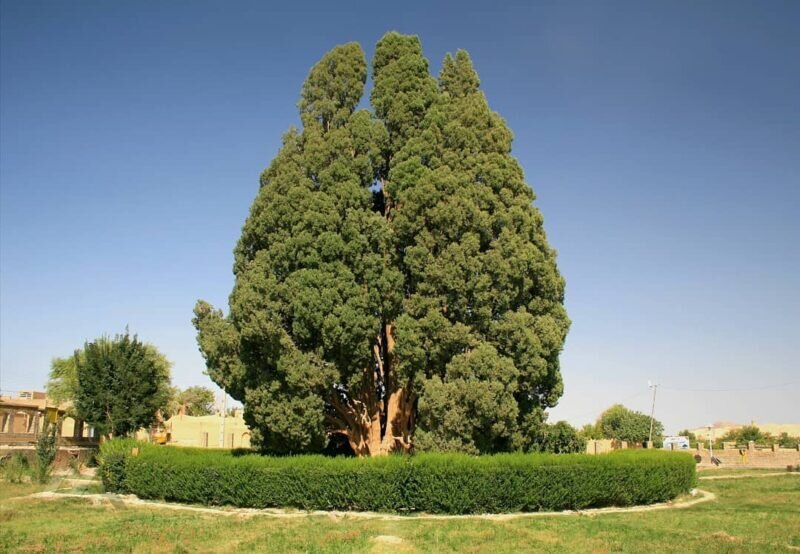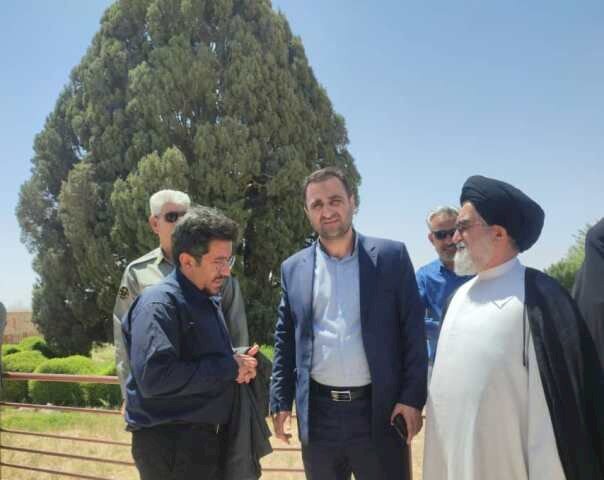Iran preparing to get 4,500-year-old cypress on UNESCO list

TEHRAN – Iran’s deputy tourism minister on Thursday said they were preparing to apply to UNESCO for listing a 4,500-year-old cypress on the Natural World Heritage list.
“Dossier for the [possible] registration of Sarv-e Abarkuh on the UNESCO list is being pursued by the Ministry of Cultural Heritage, Tourism and Handicrafts,” Ali-Asghar Shalbafian said.
Shalbafian made the remarks during a visit to the 4,500-year-old cypress, which is named after the Abarkuh town in Yazd province, central Iran, CHTN reported.
“UNESCO-designation of this long-lived tree will help tourism be further thrived here,” the official said.
Sarv-e Abarkuh is a solid, tall tree still covering itself with glory, reaching 25 meters in height, 11.5 meters in width of its trunk, and 18 meters in circumference. Although it doesn’t have the height or size of record-setting redwoods and sequoias standing near California, this Persian cypress has long been a tourist destination in central Iran for those who love to visit one of the oldest living creatures on Earth. It is a real blessing that this being has lived all this time to become a source of enjoyment for modern humans.

The gigantic cypress has unique features by which it is distinguished. The tree has worldwide popularity, a magnificent tree that surprises all the visitors with its glory. In addition to local travelers, the cypress has been visited by many scientists and researchers from across the globe as well. Narratives say that the tree has a puzzling and mysterious soul that has lived for thousands of years. In older Iranian accounts, the origin of this cypress is credited to Japheth, the child of Noah, while others believe that Zoroaster, the Iranian prophet, had planted Sarv-e Abarkuh.
From the scientific viewpoint, most experts believe that Sarv-e Abarkuh is between 4,000 and 5,000 years old though some others have estimated its existence to reach 8,000 years.
Regarding conservation and protection, it is obvious that naturally, all ancient and historical landmarks need care and protection, just like the case with Sarv-e Abarkuh, and several activities have been done to protect the straight and heavy Cypress. It is worth mentioning that the tree’s environment has changed these days. For instance, there were loads of pomegranate trees surrounding it in the past. Nowadays, with the expansion of cities and tourist and vehicle traffics, the tree’s territory seems to be in a greater need to be secured.
The cypress is encircled by fences, so visitors shouldn’t approach or touch it as when the soil is hardened due to their footsteps, it won’t have a chance to absorb water, and it will also alter micro-organisms.
Cypresses have usually have been the first preferred tree for Iranian gardens. In the famous Persian gardens, such tree plays a significant role in their design. In ancient Iran, planting a tree had great importance, as it is shown in old paintings and monuments such as Achaemenian carvings in Persepolis. Cypress is noticed in many related symbols and old Persian poetry. It can also be seen as a symbol of life and beauty in some Achaemenian sculptures.
Sarv-e AbarKuh is protected by the Cultural Heritage, Tourism, and Handicrafts Ministry of Iran as a national natural monument. The ministry has long taken some steps, like killing insects, to guarantee that the tree keeps on living for the upcoming years. Some other moves have also been made to protect the tree, including keeping it away from pests and insects harm, checking the issues related to visiting and tourism necessities, natural enclosures around the tree under current conditions to decrease tree’s damage, using a trained workforce to protect this national monument, and providing lightning protection.
Abarkuh itself is a delightful place to stay located on the once crossroads of the Silk Road and has many excellent houses and antiquity of over 4000 years. While in Abarkuh, one finds countless tourist attractions and peaceful natural sites, by visiting them, travelers may collect much more memories from their adventures. Some believe the amazing life span of the cypress has been credited to favorable conditions of its location which is partially escaped the modernization trends.
AFM
